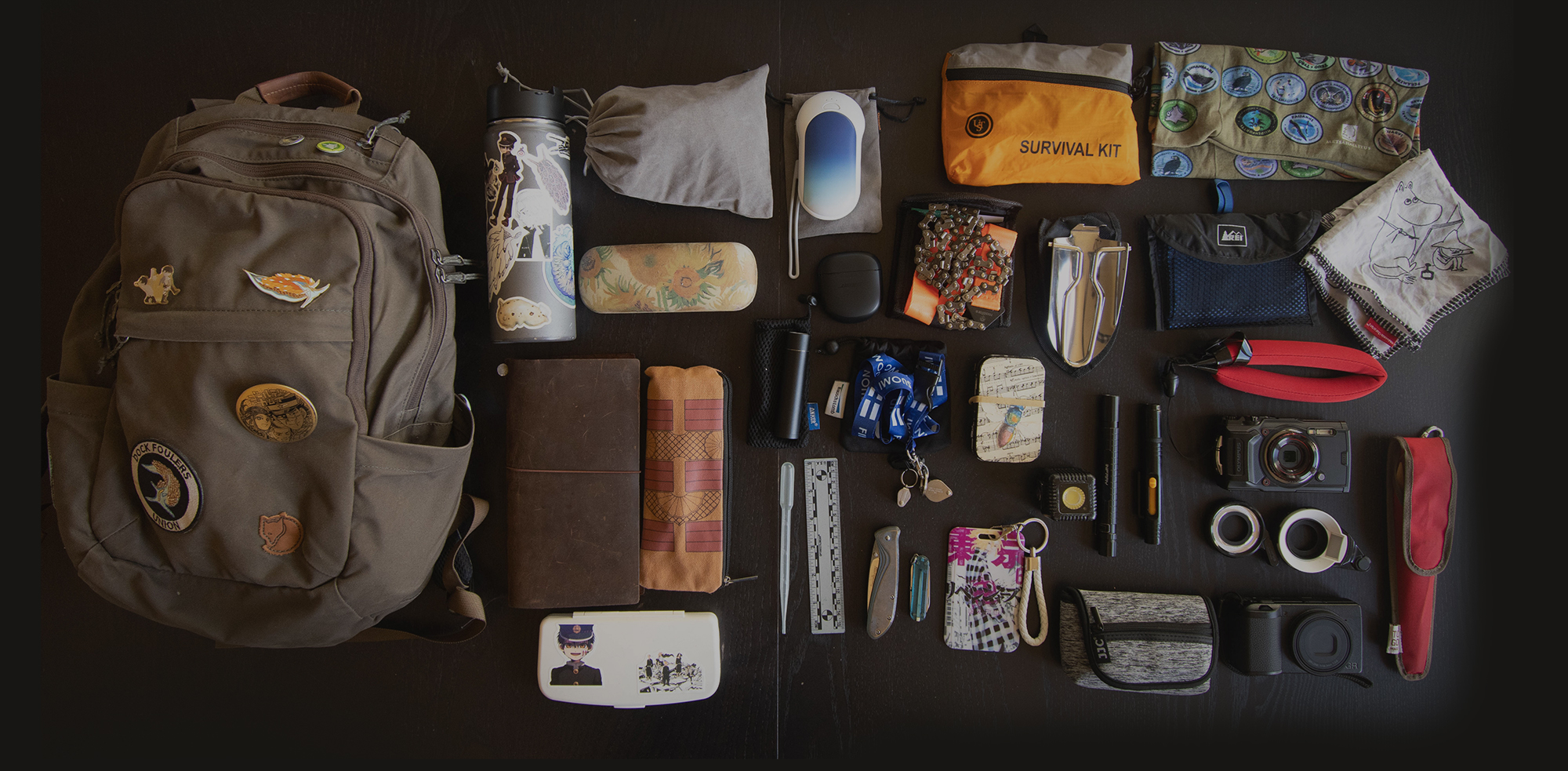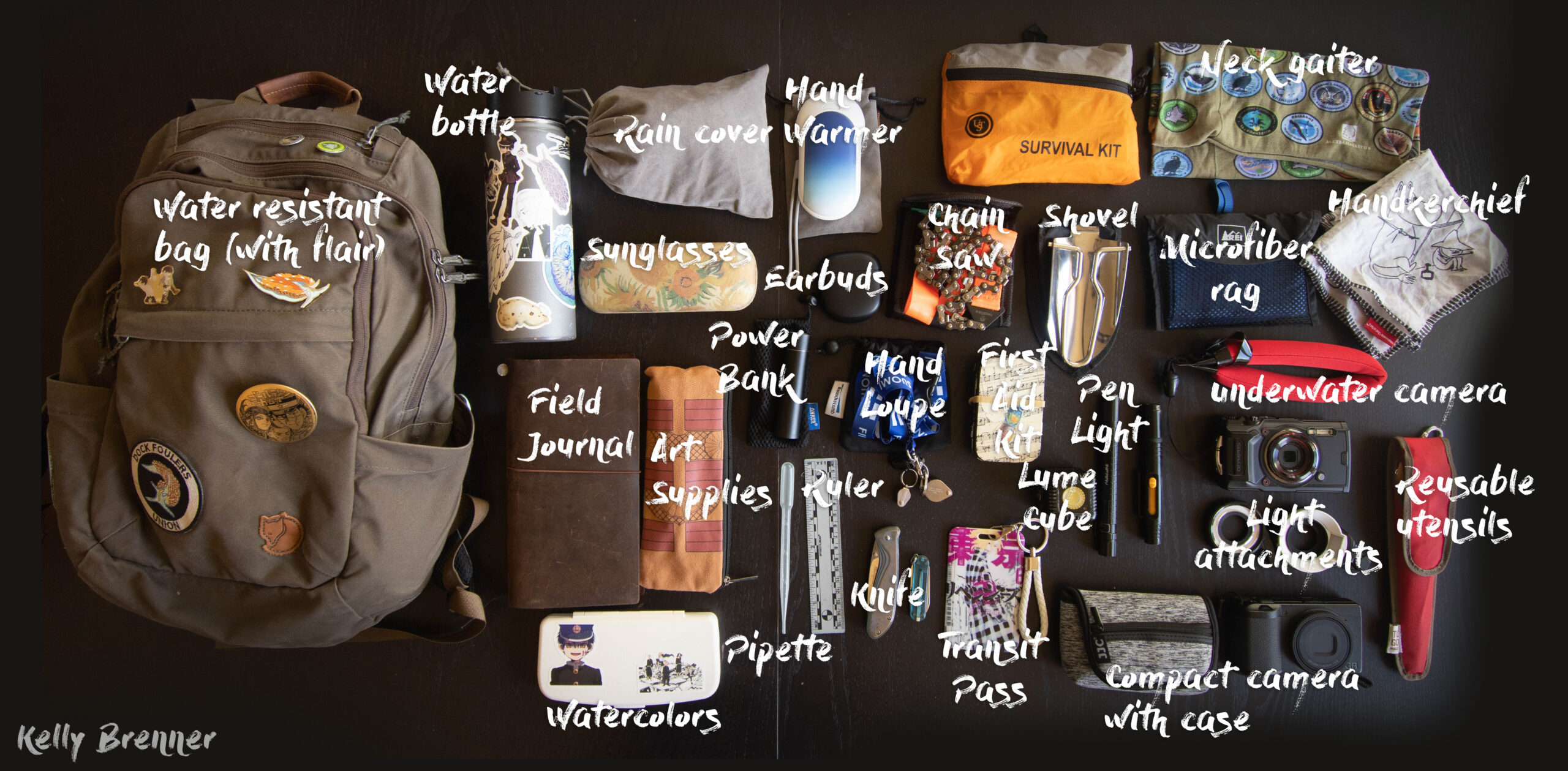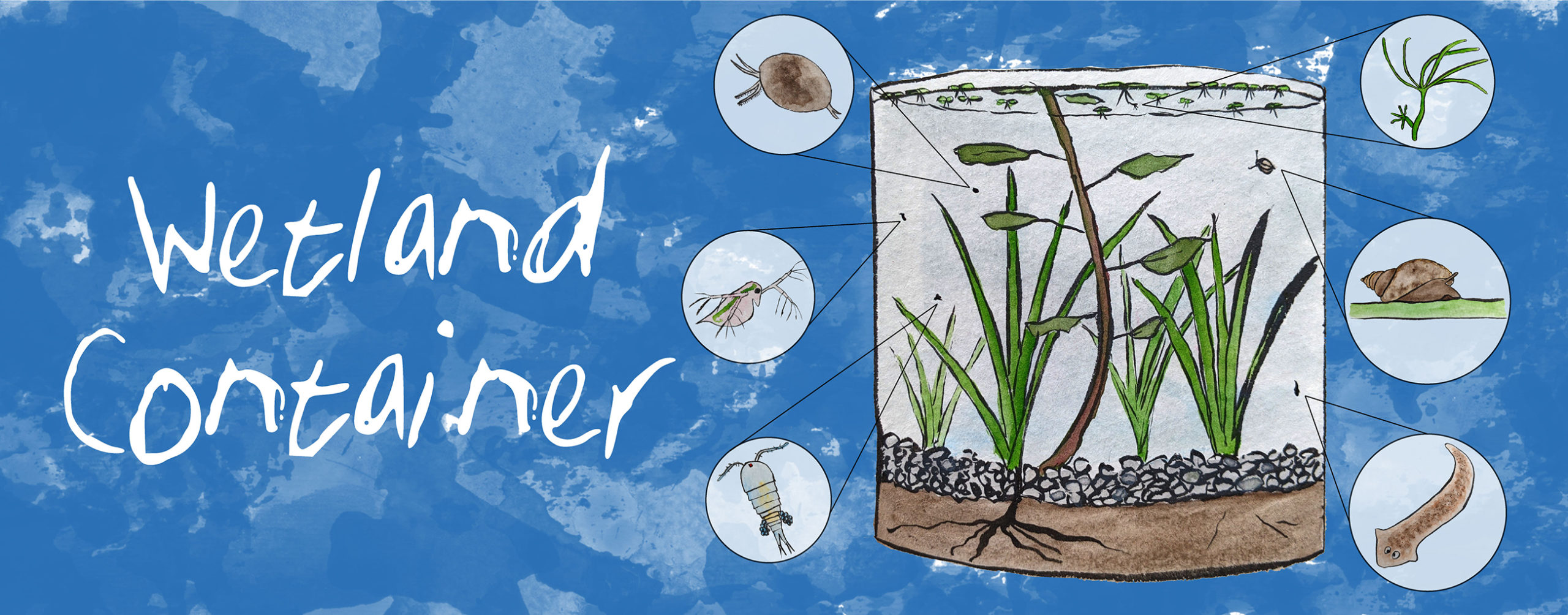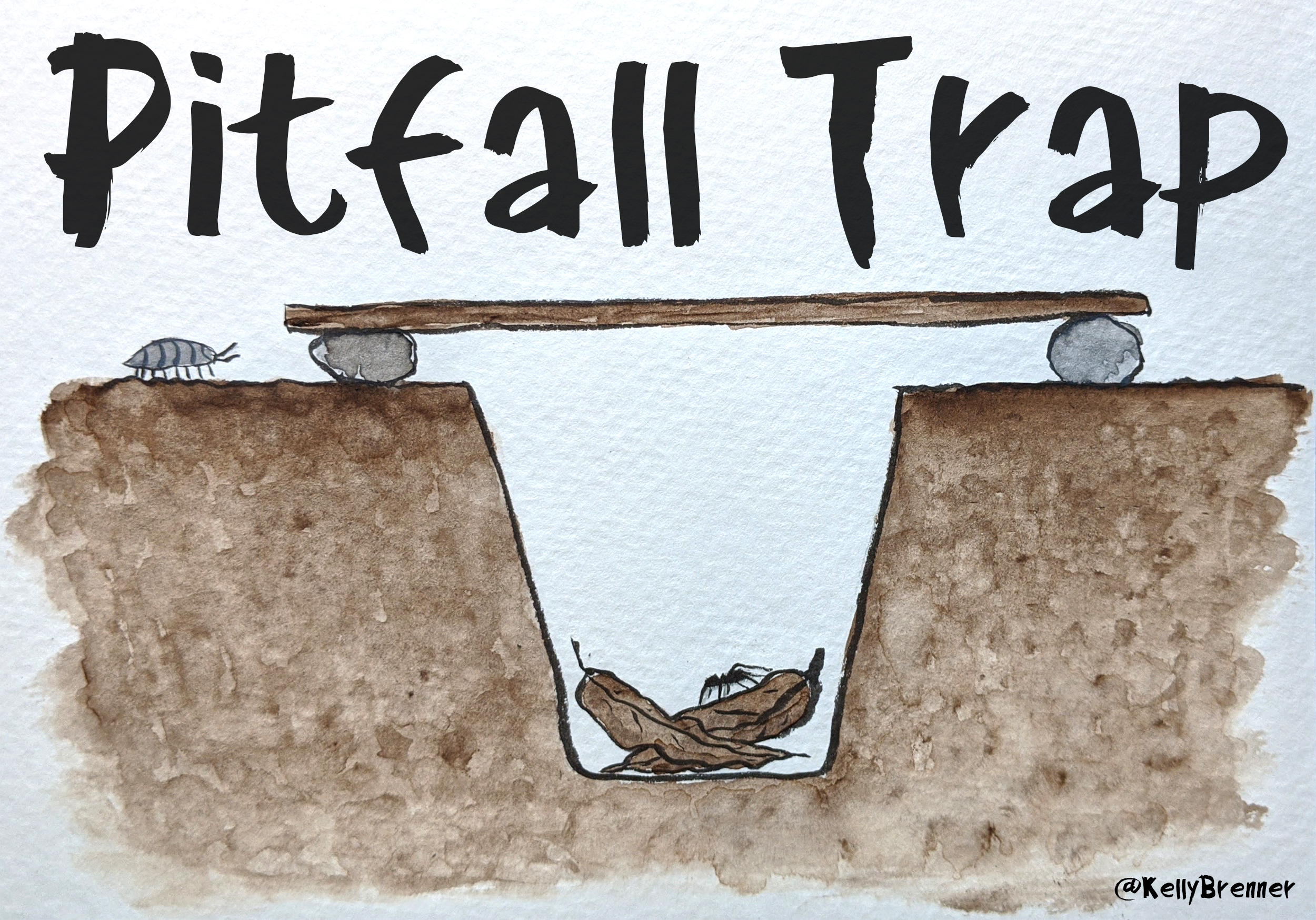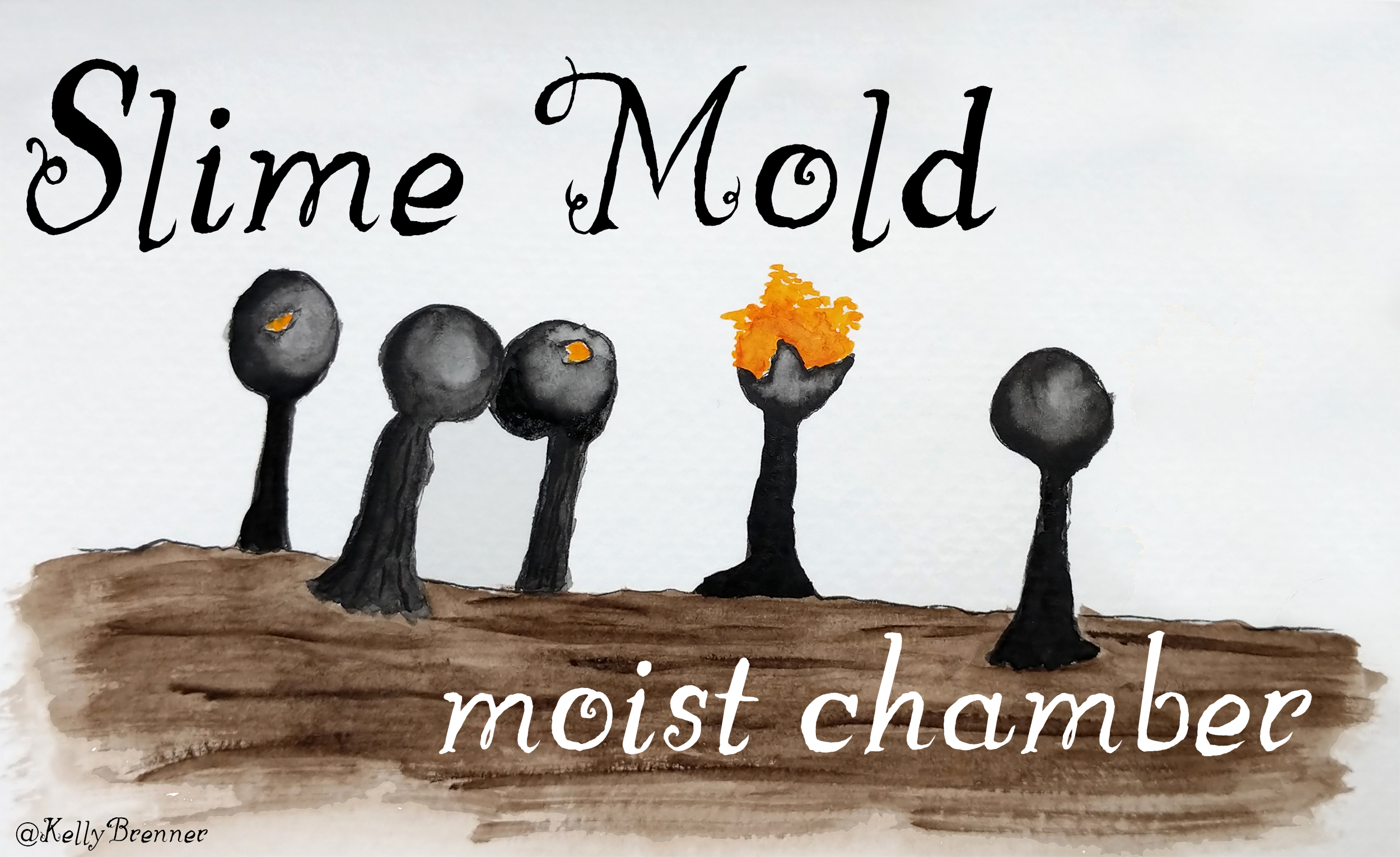One of the most common questions I receive is about my naturalist equipment. And although I always say that you don’t need anything special to be a naturalist other than the senses you already posses, there are a lot of tools which are useful and can enhance your explorations and discoveries of the natural world. I’m going to highlight what I use at home and what I carry in my field bag.
This post includes affiliate links. If you click through and buy something, you can help me acquire new materials.
Field Bag
Believe it or not, everything in the photo above easily fits into my backpack with room to spare for a lunch, snacks or rain pants. I’ve searched high and low for compact items so I can explore without breaking my back. Everything here stays in my backpack all the time and my bag goes with me everywhere. I find it easier to have one bag so I don’t have to think about moving things around, but that’s just me. What you don’t see in the photo is apparel because it changes seasonally. I always carry a neck gaiter because it’s good for warmth or too much sun as well as mosquitoes. In the summer I always keep a hat and cooling sleeves in my bag and in the winter, a fleece-lined neck gaiter, gloves and a hat. Most everything in the photo is self explanatory, and many of the items are described in greater detail below.
Hand Loupe
One of my favorite tools that is always in my bag, is a hand loupe. This is a small and powerful magnifying glass that will change the way you look at the natural world. When I first got one, it’s not an understatement to say it had a profound impact on me. All the tiny things we overlook and rarely notice are suddenly magnificent and an entire world is opened with this simple tool. A patch of orange on a twig becomes a lichen fairy garden. I wrote about the wonders of a hand loupe in Get Thee a Hand Lens! over a decade ago and I’ve never ceased to be amazed by the hidden tiny world.
Unfortunately, it looks like the specific hand loupe I have is no longer easy to find. But here’s a link anyway so you can try and find something similar. The power is perfect for looking at almost anything small and the folding design is ideal for keeping in a bag.
Flashlight
My second favorite tool to keep in my field bag is a flashlight. Just like with the hand loupe, a flashlight can really bring to light, illuminate, shine a light on (sorry, there’s no way to not use puns here) more unseen and overlooked nature. It’s most useful when in dark forests or looking under rocks during low tide, but it’s a good tool in most circumstances. Try it once and see how much is revealed with a simple light. When I search for slime molds, the flashlight is essential and it always blows my mind how much I overlook when I first glance at a rotting log and then turn the light on to reveal patches of slime molds I didn’t see at all.
This is the exact flashlight I’ve been carrying for several years. It’s water resistant and can handle rainy days or sea spray at the beach. It has an adjustable beam so you can make it really narrow to look into crevasses in rocks or trees, or more broad to sweep it over a down log. I also like that it uses regular batteries so I can use rechargeable batteries and easily charge them without a specialty charger. It’s small and light so it fits easily in my bag.
Lume Cube
A Lume Cube is another nice addition to a naturalist’s field bag. It can be used like a flashlight, but it’s also a fantastic aid for photography. The Lume Cube is incredibly bright, but it has many levels of brightness so you can adjust it. There’s a standard thread hole on the bottom so you can put it on a mini tripod too and use it to illuminate dark areas for taking photos or videos with a camera or your phone. It’s much brighter than a standard flashlight so it can really reveal a lot. And it’s waterproof so you can use it in tidepools to search for marine life or for underwater photography.
Headlamp
There are countless uses for and benefits of having a headlamp in your gear. It’s great for tidepooling during a low night tide, searching for moths at night or keeping your hands free while looking for slime molds or fungi. The exact one I have isn’t available anymore, but this one is pretty close. Look for something with a red light option because that will prevent scaring certain wildlife, like moths. Also look for one that is water resistant so you can use it in the rain or around water. Another important feature is that the lamp can be tilted. That way you can angle it down at your feet while walking, without having to tip your head down, or you can angle it at a log comfortably while in the forest.
Black Light Flashlight
A black light may not seem to be a naturalist’s tool, but like the other lights and hand loupe, it also serves to reveal a hidden world. While not necessary to keep in a field bag, it’s a nice tool to take out on occasion. Take it to the beach and shine it in the tidepools. Many marine organisms, like sea anemones and jelly fish, glow under the black light. Other organisms also glow, like scorpions, fungi and plants.
Binoculars
Perhaps one of the most standard items for a naturalist is a pair of binoculars. But I confess, it’s one that gets left home a lot mostly because they’re usually pretty big and hard to fit into a bag. However, if you’re interested in birds at all, binoculars are essential. You don’t need anything fancy and in fact, I have a pair of tiny, old Nikon binoculars that are well over 20 years old, that I still throw into my bag when I don’t want to lug around my nicer Nikon binoculars. New binoculars are very nice though because some have the ability to focus close, which is beneficial for looking at skittish insects like dragonflies and butterflies. Additionally, some are excellent in low light, like in forests, and are actually brighter when looking through them, making identifying birds much easier. The Nikon Monarch is a good pair of binoculars that is better quality than an inexpensive pair, but nowhere near as costly as some of the top brands. They’re durable, waterproof and comfortable to use.
Nikon Monarch 5 8×42 Binoculars
If you’re really interested in watching birds, whales or other organisms that tend to be more distant, you can also look for spotting scopes. However, these are definitely harder to carry so it’s not something to get unless you develop a keen interest in something specific.
Dissecting Microscope
Just like the hand loupe, a microscope has the ability to reveal another world to the naturalist. But microscopes can do so in even more dramatic fashion. Although the hand loupe is like a portable microscope, it’s still not quite a powerful as an actual microscope. With a dissecting microscope, you can study fungi, identify lichens or examine tiny invertebrates like mites, springtails and pseudoscorpions. There are two main types of microscopes, dissecting and compound. With the dissecting microscope, you look at things that are a little bigger, like a tree branch, a tuft of moss or invertebrate. The compound microscope, on the other hand, is for looking at truly microscopic things on slides. There’s a lot of overlap, tardigrades can be seen with both, for example. Under a dissecting microscope, you’ll see tardigrades, springtails, rotifers and nematodes in a petri dish, while under a compound microscope you’ll look at a single tardigrade on a slide in close up detail. The exact model of dissecting microscope I have is no longer available, but this is more or less the same thing and it’s served me quite well for many years.
Compound Microscope
If you only get one microscope as a naturalist, I’d recommend a dissecting scope. But if you can get a second, a compound microscope is definitely worth it. There are some organisms which are only easily visible with a compound microscope, like diatoms. Observing takes more work though and you’ll need slides, slip covers and a pipette for transferring organisms to slides.
Underwater Camera
Cameras are a very useful tool for documenting biodiversity, identifying species, recording the naturalist’s observations and more. For many years I only had a Nikon DSLR. Then I got an underwater camera and it opened whole new worlds for me. This Olympus is an excellent little camera and I’ve used it a lot at the beach to take photos of everything from nudibranchs to barnacles. I’ve also used it in ponds and rivers and short of diving, it’s the only way to truly see the underwater perspective. This camera can record video as well and does wonderful macro. Although it lacks true manual shooting, you can shoot in raw. It’s small and easy to keep in your field bag and it’s a pretty good all purpose camera for other photography needs as well.
Compact Camera
For many, many years I’ve hauled around a Nikon DSLR. Most recently I’ve used a Nikon D300 with a 200mm macro lens extensively. All the photography on my website was done with this setup. However, because of the bulk and weight of the camera and lens, I left it at home more and more and finally after one sore neck too many, I decided to swap to a compact camera. My priority is macro, so I did a lot of research to find a quality camera that was capable of great macro photography. I ended up with the Ricoh GRIII and so far I’ve found it to be a phenomenal camera. It takes stellar landscapes as well. And the best part is that it’s so small and light I can leave it in my bag and it never gets left at home. It shoots in full manual mode and offers raw images as well. It’s also wonderful in low light. There are drawbacks when compared to my DSLR and long macro. The Ricoh is no good for shooting birds or other things at a distance because there is no zoom. And the macro mode requires getting close to the subject, so it’s not great for capturing insects which are flighty, like certain dragonflies and butterflies. But I’m finding the benefit of always having it with me far outweighs the drawbacks.
Notebook
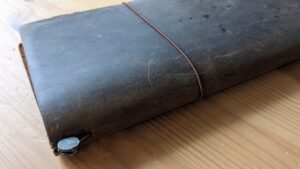
I’ve gone back and forth with carrying a notebook or nature journal with me forever and I’ve never been very consistent. But I found a notebook not long ago that worked so well for me, I now use it a lot more frequently. Although I still neglect to carry it a lot! The beauty of this particular notebook is how customizable and versatile it is. You choose a basic cover and then there are dozens of options for removable inserts. I have one insert for my writing journal and a second watercolor insert for my nature journal. There are even two sizes, a larger one and a passport size one.
Assorted Gear
There is a whole variety of odds and ends that have found their way into my field bag where they’ve stayed. I carry my bag essentially everywhere so I value anything that’s compact and light. And bonus points if it’s useful for more than one things. Here are a few of the items that live in my bag.
Knife/multitool
A knife is an essential item for many reasons like when collecting slime molds or lichens. I have a basic, fold up knife that is nothing special. Multitools are also useful because you never know what you’ll encounter as a naturalist. I have a Gerber multitool that I found in a river and cleaned up.
Fold up shovel
A small shovel is one of those tools you never knew you needed until it was in your bag. You can use it to dig up plants in the forest, clams and worms at the beach or collect leaf litter to take home for study. If your car gets stuck in the snow or mud, you can dig yourself out and if nature calls when you’re out, you’re prepared. This is similar to the one I have and it’s very compact and relatively light and the best part is it has a little case so the dirt or sand won’t get all over your bag.
Umbrella
There’s a joke in the Pacific Northwest about easily knowing someone didn’t grow up here because they use an umbrella. Although I am one of those non umbrella using people (I prefer a rain jacket), there are many uses for an umbrella for a naturalist. A dark colored umbrella is excellent at allowing you to see into water by reducing the glare, so hold it over tidepools or ponds to see into the depths easily. You can also use an umbrella turned upside down to catch invertebrates when bush beating (which is a project covered in my next book The Naturalist at Home). And while rain jackets are excellent for staying dry and keeping hands free, if you’re trying to take photos in the rain, an umbrella can help protect your camera. I generally keep one in my car instead of my bag.
Bug net, Aspirator
If you have an interest in observing or documenting invertebrates, a couple of specialty items can be very useful. There are many types of bug nets and some of them fold down fairly small. These are essential for catching bugs like dragonflies and butterflies. This isn’t generally necessary and it’s often better to just observe or take photos, but some species can only be identified in hand and require catching. I don’t generally carry one unless I specifically need it.
An aspirator is a container with tubes attached and works as a vacuum, sucking the invertebrates into the container where they can be observed. Both of these items can be found at entomology supply stores.
Tins/Jars/Bags
Naturalists are always bringing bits of nature home so it’s nice to have a small collection of containers in your field bag. I keep old mint tins, vials, and other random containers in my bag for the odd moss or dead invertebrate I happen upon. When I collect slime molds, I take a craft box with adjustable dividers, like this one.
Microfiber cloth
Being in nature is messy and dirty, so I keep a small, quick drying microfiber cloth in my bag. It’s good for cleaning up mud or other messes and it’s also good for drying the lens of an underwater camera when switching between underwater and above water. Mine gets used quite regularly.
First Aid Kit
You can buy a small first aid kit, but you can just as easily make a miniature one of your own from an old mint tin. Mine has bandages, alcohol wipes, sting ointment, a tick remover, pain killers, safety pins and so on, all held together with a rubber band. I also keep a basic survival kit in my bag, especially when I go out on longer adventures.
Phone
Many purists will tell you to leave your phone at home when you go outside into nature, but I’m not one of them. Take your phone, it’s a powerful tool. You can use it to take photos, videos and audio recordings of the nature you encounter. You can also download trail maps, search for campgrounds and find out where you are when you get lost. There are also dozens of nature apps including everything from identifying birds and dragonflies to plants and looking up the time of low tide. Just turn it to do not disturb so nobody can bother you while you’re outside enjoying nature.

